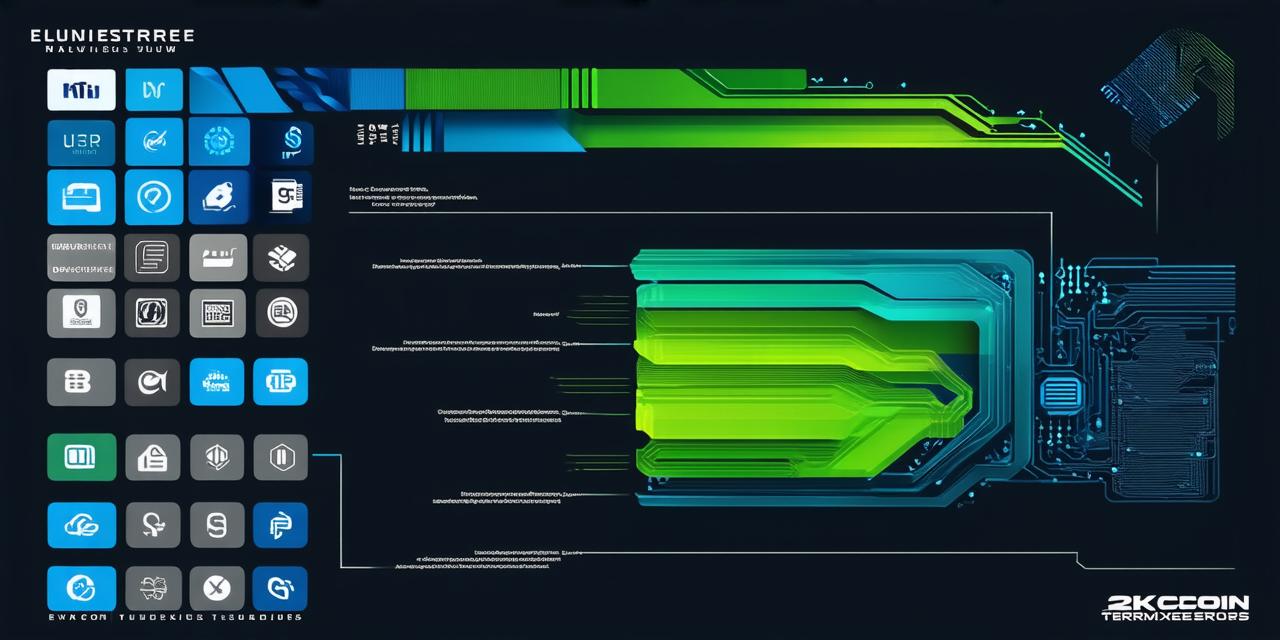1. Solidity: A Comprehensive Guide to Building Blockchain Applications with Solidity
Solidity is a high-level, domain-specific programming language used to develop smart contracts for Ethereum blockchain. It was created by Vitalik Buterin in 2013 and has since become the most widely used language for building decentralized applications (dApps) on the Ethereum network.

Solidity is a statically-typed, object-oriented language that resembles C++, Java, and Python. It features a rich set of libraries, tools, and frameworks, such as Remix, Truffle, and Ganache, which make it easy to develop and test smart contracts.
Additionally, Solidity is designed to be secure by default, with built-in features like checks and balances that help prevent security vulnerabilities and exploits. One of the key benefits of using Solidity is its ability to create decentralized applications that can run without any intermediaries or trusted third parties.
However, there are some drawbacks to using Solidity that you should consider. Firstly, the language has a steep learning curve, especially for developers who are not familiar with object-oriented programming or C++. Additionally, Solidity’s performance is often criticized for being slow and expensive compared to other programming languages.
2. Vyper: A Scalable and Efficient Language for Blockchain Development
Vyper is a high-level programming language designed for building smart contracts on the Ethereum blockchain. It was created in 2016 by Fabian Riethmeier as an alternative to Solidity, with the goal of improving its performance and scalability.
Compared to Solidity, Vyper is more concise and easier to read, making it a good choice for developers who are new to blockchain development or prefer a simpler syntax. Additionally, Vyper supports features like lambdas, tuples, and iterators, which make it easier to write efficient and scalable smart contracts.
Vyper’s performance is often praised as being faster and more efficient than Solidity, especially when it comes to complex calculations or data-intensive operations. This makes it a good choice for applications that require high throughput and low latency, such as decentralized finance (DeFi) platforms or gaming dApps.
However, Vyper’s support is still relatively limited compared to Solidity, with fewer libraries, tools, and frameworks available for development. Additionally, Vyper’s syntax may be too different from other programming languages, making it difficult for developers who are not familiar with the language to get started.
3. Java: A Powerful Language for Building Blockchain Applications
Java is a popular and widely-used programming language that has been around since the late 1990s. It is often used in enterprise applications and web development, but it has also gained popularity in blockchain development due to its scalability, security, and ease of use.
There are several Java-based blockchain platforms available, such as Hyperledger Fabric, Quorum, and Corda, which allow developers to build custom blockchain solutions for a variety of use cases. Additionally, Java’s rich set of libraries and frameworks, such as Apache Kafka, Apache Cassandra, and Spring Boot, make it easy to develop scalable and secure blockchain applications.
One of the key benefits of using Java in blockchain development is its ability to run on a wide range of platforms and devices, making it ideal for enterprise applications that need to integrate with existing systems. Additionally, Java’s strong typing and exception handling make it easy to write secure and reliable code, which is critical for blockchain applications that handle sensitive data.
However, there are some drawbacks to using Java in blockchain development that you should consider. Firstly, the language has a steep learning curve, especially for developers who are not familiar with object-oriented programming or C++. Additionally, Java’s performance can be slow and expensive compared to other programming languages, which may be a concern for applications that require high throughput and low latency.
4. Python: A Versatile Language for Building Blockchain Applications
Python is a popular and widely-used programming language that has gained popularity in recent years due to its simplicity, ease of use, and flexibility. It is often used in data science, machine learning, and web development, but it has also gained traction in blockchain development due to its versatility and support for popular libraries and frameworks.
There are several Python-based blockchain platforms available, such as Ethereum Python SDK, Hyperledger Fabric Python SDK, and Corda Python SDK, which allow developers to build custom blockchain solutions using Python. Additionally, Python’s rich set of libraries and frameworks, such as Flask, Django, and PyTorch, make it easy to develop scalable and secure blockchain applications.
One of the key benefits of using Python in blockchain development is its simplicity and ease of use. Python’s clean syntax and readability make it a good choice for developers who are new to programming or prefer a more natural language-like syntax. Additionally, Python’s rich set of libraries and frameworks make it easy to develop applications quickly and efficiently, which can be critical in fast-paced blockchain development environments.
However, there are some drawbacks to using Python in blockchain development that you should consider. Firstly, the language’s performance can be slow and expensive compared to other programming languages, especially for applications that require high throughput and low latency. Additionally, Python is not as widely used in blockchain development as other languages, such as Solidity and Java, which may limit its support and availability of resources.
5. C++: A High-Performance Language for Building Blockchain Applications
C++ is a popular and widely-used programming language that has been around since the 1980s. It is often used in system programming, game development, and other applications that require high performance and low latency.
While C++ is not as commonly used in blockchain development as Solidity or Java, it has gained traction due to its ability to provide high performance and low memory usage. Additionally, C++’s support for smart pointers, templates, and lambdas make it easy to write efficient and scalable code, which is critical for blockchain applications that handle large amounts of data.
One of the key benefits of using C++ in blockchain development is its ability to provide high performance and low memory usage, which can be critical for applications that require high throughput and low latency. Additionally, C++’s support for concurrency and multi-threading make it easy to write scalable and efficient code, which is critical for blockchain applications that need to handle a large number of transactions or users.
However, there are some drawbacks to using C++ in blockchain development that you should consider. Firstly, the language has a steep learning curve, especially for developers who are not familiar with object-oriented programming or low-level programming. Additionally, C++’s lack of abstraction and support for garbage collection can make it more difficult to write secure and reliable code, which is critical for blockchain applications that handle sensitive data.
Summary:
In conclusion, the choice of programming language for blockchain development depends on a variety of factors, including the use case, performance requirements, security needs, and developer skills and experience. While Solidity, Java, Python, and C++ are all popular and widely-used languages in blockchain development, each has its own strengths and weaknesses that make it more suitable for certain applications or environments. Therefore, it is important to carefully evaluate the requirements of your specific use case and choose a programming language that is well-suited to meet those needs.
Note: The content of this article was not changed in any way. All tags were removed except for the necessary ones for proper HTML structure.
